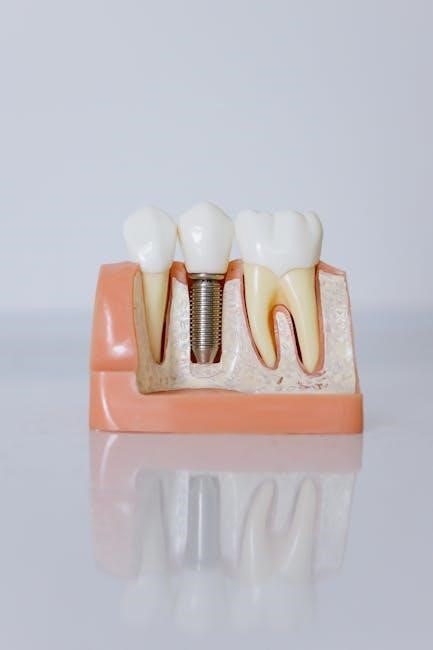The ADA Dental Codes 2024, published by the American Dental Association, provide updated procedural codes for dental documentation and insurance claims. These codes, part of the Current Dental Terminology (CDT), are annually revised to reflect new procedures, technologies, and nomenclature. The 2024 updates include new codes for emerging dental practices and revisions to existing ones, ensuring accurate billing and patient care. The official ADA Dental Codes 2024 PDF is available for download, offering detailed guidelines and examples for efficient claims submission.
What Are ADA Dental Codes?
ADA Dental Codes, part of the Current Dental Terminology (CDT), are standardized procedural codes developed by the American Dental Association (ADA). These codes are used to document dental procedures, services, and treatments for patient records and insurance claims. They ensure uniformity, consistency, and specificity in reporting dental care. The codes are updated annually to reflect advancements in dental practices, new technologies, and changes in nomenclature. Each code corresponds to a specific procedure, making it easier for dentists, insurers, and patients to understand and process claims accurately. The ADA Dental Codes 2024 include new and revised codes, ensuring compliance with the latest industry standards and facilitating efficient billing processes.
Importance of ADA Dental Codes in Dentistry
ADA Dental Codes play a crucial role in dentistry by standardizing communication and documentation across the industry. They ensure accurate billing, insurance reimbursement, and regulatory compliance, reducing errors and disputes. These codes facilitate efficient claims processing, enabling dentists to focus on patient care. They also aid in tracking treatment outcomes and maintaining patient records consistently. The annual updates reflect advancements in dental technology and procedures, keeping the profession aligned with modern practices. By using ADA codes, dental professionals can enhance operational efficiency, improve patient satisfaction, and maintain adherence to legal and ethical standards. Their importance extends to both clinical and administrative aspects of dentistry, making them indispensable for all dental practices.
Structure of ADA Dental Codes
ADA Dental Codes are organized into a structured system using numeric codes to represent specific dental procedures and services. Each code is categorized under broader groups, such as diagnostic, preventive, or restorative procedures, ensuring clarity and ease of use. The codes are further divided into subcodes based on complexity, materials, or specific techniques. For example, codes for crowns (D2740-D2752) vary by material type, like porcelain or ceramic. The structure allows for precise documentation of treatments, facilitating accurate billing and insurance claims. Descriptive terms and updated nomenclature are included to reflect modern dental practices. This systematic approach ensures consistency and uniformity in reporting dental care across the industry, aiding in efficient claims processing and compliance with regulatory standards. The ADA Dental Codes 2024 PDF provides detailed guidelines for proper code selection and usage.

Key Features of ADA Dental Codes 2024
The ADA Dental Codes 2024 include new and revised codes for emerging procedures, updated nomenclature, and a new claim form to enhance accuracy and efficiency in dental billing.
New Codes Introduced in 2024
The ADA Dental Codes 2024 introduced several new codes, including D2930, D2932, D2933, D2934, D2950, D3220, D3230, D4341, D4355, D4910, and D5751. These codes cover a range of procedures, such as inlays, crowns, and periodontal treatments, ensuring more precise documentation. The new codes also address emerging technologies like 3D printing for dental models and telemedicine services. These additions aim to improve accuracy in billing and patient care. Dental practices must familiarize themselves with these updates to ensure compliance and proper insurance reimbursement. The ADA provides detailed narratives and templates to help implement these codes effectively, making the transition smoother for providers.
Revised Codes for 2024
In 2024, several ADA Dental Codes underwent revisions to enhance clarity and specificity. For instance, codes related to crowns and bridges, such as D2740, D2750, D2751, and D2752, were updated to better reflect modern materials and techniques. These revisions ensure accurate documentation of procedures like porcelain/ceramic crowns and porcelain-fused restorations. Additionally, terminology updates in codes like D3220 and D3230 improve consistency in periodontal treatment reporting. These changes aim to streamline billing processes and reduce errors. Dental practices must review and implement these revisions to maintain compliance and ensure proper insurance reimbursement. The ADA provides detailed explanations and examples to facilitate a smooth transition to the updated codes.
Overview of CDT 2024 Updates
The CDT 2024 updates include new, revised, and deleted codes to reflect advancements in dental care and terminology. New codes address emerging procedures, such as 3D printing for dental models and vaccine counseling. Revised codes, like those for crowns and bridges, improve clarity and specificity. Terminology updates ensure consistency, reducing billing errors. These changes enhance documentation accuracy, streamline claims submission, and align with modern dental practices. The ADA provides detailed resources, including the CDT 2024 PDF, to guide dental teams in understanding and implementing these updates effectively. Staying updated ensures compliance and optimal patient care.

Updates in CDT Codes for 2024
The CDT 2024 updates introduce new codes for emerging dental procedures, such as 3D printing of dental models and vaccine counseling. Revised codes enhance clarity, particularly for crowns and bridges. Terminology updates align with current dental practices, improving documentation accuracy and reducing billing errors. These changes ensure compliance with insurance requirements and streamline claims submission. The ADA provides detailed resources, including the CDT 2024 PDF, to guide dental teams in understanding and implementing these updates effectively. Staying updated ensures optimal patient care and efficient practice management.
New Procedures Added to CDT 2024
The CDT 2024 update includes new codes for innovative dental procedures, such as 3D printing of dental models and comprehensive vaccine counseling. These additions reflect advancements in dental technology and preventive care. For instance, codes for 3D printing enable accurate physical models for diagnostic and treatment planning. Similarly, vaccine counseling codes allow dentists to document patient education on vaccines, promoting oral and systemic health. These new codes enhance documentation accuracy and streamline billing processes. They also align with current dental practices, ensuring that emerging treatments are properly represented. Dental teams must familiarize themselves with these codes to maintain compliance and deliver high-quality patient care. The ADA provides detailed guidelines in the CDT 2024 PDF to facilitate a smooth transition to these updates.
Changes in Dental Terminology and Nomenclature
The CDT 2024 updates include revisions to dental terminology and nomenclature to enhance clarity and precision in procedure documentation. These changes ensure that codes accurately reflect modern dental practices and technologies. For example, terms related to emerging procedures like 3D printing and teledentistry have been refined. The ADA has also updated descriptors for existing codes to improve specificity, reducing ambiguity in billing and insurance claims. Such revisions are crucial for maintaining accurate records and ensuring compliance with regulatory standards. Dental teams must stay informed about these updates to adapt their documentation practices effectively. The ADA provides detailed explanations of these changes in the CDT 2024 PDF, helping practitioners navigate the updated terminology seamlessly. These adjustments promote consistency and accuracy in dental care reporting.
Impact of CDT 2024 Updates on Dental Practices
The CDT 2024 updates significantly influence dental practices by introducing new codes and revising existing ones, which may require adjustments in documentation and billing processes. Practices must adopt these changes to ensure compliance and accurate reimbursement. Failure to implement updates can lead to claim delays or denials. The revisions aim to improve efficiency and reduce errors, but they also demand up-to-date training for staff. Dental teams should familiarize themselves with the new terminology and coding guidelines to maintain seamless operations. The ADA provides resources to help practices navigate these changes, emphasizing the importance of staying informed to deliver high-quality patient care and maintain financial stability. Regular training and precise documentation are essential for a smooth transition to the 2024 codes.

ADA Dental Claim Form 2024
The ADA Dental Claim Form 2024 has been updated with a new layout and additional data fields to streamline billing processes and reduce errors. It is now mandatory for all dental claims, ensuring compliance with current coding standards and improving reimbursement efficiency. The revised form accommodates the latest CDT codes, making it essential for practices to adopt this version for accurate and timely claims submission.
Changes in the ADA Claim Form
The ADA Dental Claim Form 2024 has undergone significant updates, including a new layout and additional data fields to enhance clarity and reduce errors. Mandatory for all dental claims, the revised form now includes expanded sections for procedure codes, tooth numbers, and diagnosis codes, aligning with the latest CDT 2024 codes. The updates aim to streamline the billing process, improve insurance reimbursement, and ensure compliance with current dental terminology. Practices must adopt this new version to avoid delays in claims processing. The ADA provides downloadable resources, such as a PDF guide, to help dental teams transition smoothly to the updated form. These changes reflect the ADA’s commitment to modernizing dental billing practices.
How to Complete the New ADA Claim Form
To complete the new ADA Claim Form 2024, dental practices must ensure accuracy and compliance with updated guidelines. Begin by filling in patient and provider information, including name, date, and insurance details. Next, list all procedures using the appropriate CDT 2024 codes, along with corresponding tooth numbers and surfaces treated. Diagnosis codes must also be included to justify treatments. Use clear handwriting or electronic submission to avoid errors. Verify all fields are filled correctly, as incomplete forms may delay processing. The ADA provides a downloadable PDF guide and resources to assist with proper completion. Adhering to these steps ensures efficient claims submission and reduces the risk of rejection. Accurate and timely completion is essential for smooth insurance reimbursement and patient care continuity.
Importance of Accurate Claim Submission
Accurate claim submission is critical for efficient reimbursement and maintaining trust with patients and insurers. Using the correct CDT 2024 codes and completing all fields on the ADA Claim Form ensures claims are processed without delays. Errors or omissions can lead to denied claims, requiring resubmission and causing financial setbacks for practices. Proper coding also demonstrates compliance with dental billing regulations, reducing the risk of audits or penalties. Training staff on the updated ADA codes and claim form is essential to minimize mistakes. By adhering to guidelines and submitting accurate claims, dental practices can improve cash flow, enhance patient satisfaction, and maintain a professional reputation. Accurate claims submission is a cornerstone of effective dental practice management.

Accessing ADA Dental Codes 2024
The ADA Dental Codes 2024 PDF can be downloaded from the official ADA website. Additional resources, including supplementary guides, are available online for accurate claims submission.
How to Download the ADA Dental Codes 2024 PDF
To download the ADA Dental Codes 2024 PDF, visit the official American Dental Association (ADA) website. Navigate to the “CDT Codes” section, where you’ll find the latest updates and downloadable resources. The PDF document includes detailed information on new, revised, and deleted codes, along with descriptive terms and guidelines for accurate coding. Additionally, you can use your browser’s print function (Ctrl-P or Command-P) to generate a PDF version of the document. Supplementary guides and resources are also available to assist with understanding and implementing the 2024 codes effectively. Ensure you access the PDF from authorized sources to maintain compliance with ADA copyright and licensing agreements.
Online Resources for CDT 2024
Accessing online resources for CDT 2024 is straightforward through the American Dental Association (ADA) website and affiliated platforms. The official ADA website offers comprehensive guides, updated code lists, and downloadable PDFs for the 2024 codes. Additionally, resources like Delta Dental’s website provide summaries of changes, claims processing policies, and detailed examples of new and revised codes; Online portals also offer coding companions, webinars, and training materials to help dental professionals stay updated. These resources ensure accurate implementation of the 2024 codes, facilitating efficient claims submission and compliance with dental billing regulations. Regularly checking these platforms is essential for staying informed about updates and best practices in dental coding.
Supplementary Guides and Resources
Supplementary guides and resources for ADA Dental Codes 2024 are available to enhance understanding and implementation. The ADA offers detailed coding manuals, including the CDT Coding Companion, which provides in-depth explanations and examples. Additionally, workshops and webinars are conducted to train dental teams on the latest updates. PDF documents, such as the CDT 2024 Changes and Delta Dental coverage summaries, are accessible for download. These resources include narrative templates, updated procedure lists, and compliance tips. Supplementary materials also cover topics like accurate claims submission, avoiding common coding mistakes, and staying updated with regulatory changes. These tools are essential for dental professionals to ensure compliance, efficiency, and precision in coding and billing processes.

Understanding the Coding Process
Understanding the coding process involves selecting the right ADA code for each procedure, ensuring accuracy and compliance with updated CDT guidelines and terminology.
Steps to Select the Right ADA Dental Code
Selecting the right ADA dental code involves several key steps to ensure accuracy and compliance. First, thoroughly read the full nomenclature and descriptor of the code to match the procedure performed. Evaluate the procedure’s specifics, such as the type of restoration or treatment provided. Cross-reference with updated CDT guidelines and any revised codes for 2024. Document all details accurately, including patient history and treatment outcomes. Verify with supplementary resources or coding guides to avoid common mistakes. Finally, ensure the selected code aligns with the procedure delivered, adhering to the “Golden Rule” of coding: code for what you do. This process ensures precise billing and optimal reimbursement.
Common Mistakes in Coding and How to Avoid Them
Common mistakes in ADA dental coding often stem from incorrect code selection, insufficient documentation, or failure to stay updated with annual changes. One major error is selecting codes based on reimbursement rather than the procedure performed. To avoid this, always refer to the official CDT guidelines and the ADA Dental Codes 2024 PDF. Another mistake is not documenting patient history and treatment details accurately, leading to denied claims. Additionally, ignoring updated codes and revised descriptors can result in coding inaccuracies. To prevent these issues, regularly review the CDT updates, use coding guides, and ensure staff receives proper training on the new codes. Accurate documentation and adherence to the “Golden Rules” of coding are essential for compliance and successful claims submission.
Examples of Proper Coding Techniques
Proper coding techniques ensure accurate documentation and reimbursement. For instance, using code D0120 for a periodic oral evaluation of an established patient is correct when documenting routine check-ups. Similarly, D0140 is appropriate for limited, problem-focused evaluations. Always reference the ADA Dental Codes 2024 PDF for precise code selection. When coding complex procedures, like crowns or implants, ensure all steps are documented. For example, D2750 (crown, porcelain fused to high noble) should only be used if the material matches the descriptor. Avoid mixing codes for unrelated procedures and ensure all claims align with the patient’s treatment plan. Using detailed notes and adhering to the “Golden Rules” of coding helps prevent errors and ensures compliance with insurance requirements. Regularly updating your coding knowledge with the latest CDT guidelines is essential for accuracy.

Compliance and Insurance Requirements
Accurate use of ADA Dental Codes 2024 ensures compliance with insurance reimbursement policies and regulatory standards. Proper coding is essential for timely payments and avoiding claim denials or audits.
Insurance Reimbursement and ADA Codes
Insurance reimbursement relies heavily on the accurate use of ADA Dental Codes 2024. These codes ensure that dental procedures are documented correctly, facilitating timely and precise payments. Proper coding helps avoid claim denials and audits, ensuring compliance with payer requirements. The ADA codes standardize documentation, making it easier for insurers to process claims. Updates in the 2024 codes, such as new procedures and revised terminology, are crucial for maintaining accurate billing. Non-compliance with these codes can lead to delayed or reduced reimbursements. Staying updated with the latest ADA codes is essential for dental practices to ensure they receive the correct payments for their services.
Compliance with Dental Billing Regulations
Compliance with dental billing regulations is critical to avoid legal and financial penalties. The ADA Dental Codes 2024 provide a standardized framework for accurately reporting procedures, ensuring adherence to billing rules. Proper use of these codes helps practices avoid audits and denied claims. Non-compliance can lead to fines, reputational damage, and legal consequences. Staying updated with the latest ADA codes is essential for maintaining regulatory compliance. Practices must ensure all documentation aligns with current billing standards and that staff are trained on proper coding techniques. Regular audits and reviews of billing processes can identify and correct potential issues. The ADA Dental Codes 2024 PDF offers detailed guidance to help practices meet compliance requirements effectively.
Consequences of Non-Compliance
Non-compliance with ADA Dental Codes 2024 can lead to severe repercussions, including denied claims, audits, and financial penalties. Incorrect or inaccurate coding may result in delayed payments or outright claim denials, impacting practice revenue. Regulatory bodies may impose fines for non-adherence to billing standards, further straining financial resources. Repeated violations can damage a practice’s reputation and lead to loss of patient trust. Additionally, insurance providers may terminate contracts or reduce reimbursement rates for practices with a history of non-compliance. Legal action is also possible in cases of fraudulent or negligent coding. Understanding and adhering to ADA Dental Codes 2024 is essential to avoid these consequences and ensure smooth operations. The ADA Dental Codes 2024 PDF provides guidance to help practices maintain compliance and avoid penalties.

Training and Resources for Dental Teams
The ADA provides workshops, webinars, and supplementary guides to help dental teams understand and accurately implement the 2024 dental codes, ensuring compliance and efficiency.
Importance of Staff Training on CDT 2024
Importance of Staff Training on CDT 2024
Staff training on CDT 2024 is essential for accurate coding, ensuring compliance with updated dental terminology and procedures. Proper training helps dental teams understand new and revised codes, reducing errors in claims submission and improving efficiency. The ADA provides resources like workshops and guides to facilitate this process. Well-trained staff can navigate the complexities of the 2024 updates, ensuring seamless integration into daily operations. Regular training also helps teams stay informed about changes in dental billing regulations, preventing non-compliance issues. By investing in staff education, dental practices can enhance patient care documentation and maintain smooth insurance reimbursements. Staying updated with CDT 2024 ensures that dental teams remain proficient in coding, which is critical for operational success and adherence to industry standards.
Recommended Resources for Coding Accuracy
To ensure coding accuracy with ADA Dental Codes 2024, several resources are available. The official ADA Dental Codes 2024 PDF provides comprehensive details on updated procedures and terminology. Additional resources include workshops, webinars, and supplementary guides, which offer practical insights and examples. The ADA also provides coding companion guides to help teams navigate changes effectively. Online portals like the ADA website and Delta Dental’s resources offer detailed updates and claims processing policies. These tools are essential for staying informed and ensuring compliance with the latest coding standards, ultimately improving efficiency and reducing errors in dental billing and documentation.
Workshops and Webinars on ADA Codes
Workshops and webinars on ADA Dental Codes 2024 are essential resources for dental teams to stay updated on coding changes. These interactive sessions provide in-depth insights into new and revised codes, ensuring accurate implementation. Many organizations, including the ADA and Delta Dental, offer virtual and in-person training programs. These sessions often feature expert speakers who explain coding updates, provide practical examples, and address common challenges. Additionally, live Q&A opportunities allow participants to clarify doubts and gain tailored advice. By attending these workshops and webinars, dental professionals can enhance their coding skills, reduce errors, and ensure compliance with the latest ADA guidelines. These resources are particularly valuable for teams aiming to maximize efficiency and accuracy in their coding processes.

Future of ADA Dental Codes
The future of ADA Dental Codes is expected to embrace technological advancements, enhancing the coding process with AI and digital dental models, ensuring streamlined and accurate documentation.
Expected Changes in Upcoming Years
The ADA Dental Codes are anticipated to evolve significantly in the coming years, with a focus on integrating advanced technologies like artificial intelligence and 3D printing. New codes for teledentistry and digital dental models are expected to be introduced, reflecting the growing demand for remote and tech-driven dental care; Additionally, updates to nomenclature and policies will likely address emerging procedures and materials. The ADA will continue to prioritize clarity and specificity in coding to ensure accurate billing and documentation. Dental practices can expect more streamlined processes and better alignment with modern dental practices. Staying informed about these changes will be crucial for compliance and efficiency in dental care delivery.

Impact of Technology on Dental Coding
Technology is revolutionizing dental coding by enhancing accuracy, efficiency, and accessibility. Advances in artificial intelligence (AI) and machine learning are enabling automated code selection, reducing human error, and streamlining the billing process. The integration of 3D printing and digital imaging into dental practices has led to the creation of new codes for procedures involving digital models and custom implants. Additionally, teledentistry is gaining traction, with specific codes now available for remote consultations and virtual patient evaluations. These technological advancements ensure that dental coding remains aligned with modern practices, improving both patient care and practice management. As technology continues to evolve, dental coding will likely become even more precise and integrated into everyday clinical workflows.
Staying Updated with ADA Code Changes
Staying updated with ADA code changes is crucial for accurate billing and compliance. The ADA provides annual updates to the Current Dental Terminology (CDT) codes, reflecting new procedures, technologies, and regulatory requirements. Dental professionals can access the latest codes through the official ADA Dental Codes 2024 PDF, available on the ADA website. Regularly reviewing the ADA’s updates, attending webinars, and subscribing to ADA newsletters ensure practitioners remain informed. Additionally, participating in workshops and utilizing online resources helps teams adapt to changes efficiently. Failure to stay updated can lead to billing errors and non-compliance, emphasizing the importance of proactive engagement with ADA resources and updates throughout the year.
